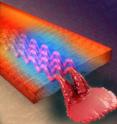Vascular composites enable dynamic structural materials
Related images
(click to enlarge)
Taking their cue from biological circulatory systems, University of Illinois researchers have developed vascularized structural composites, creating materials that are lightweight and strong with potential for self-healing, self-cooling, metamaterials and more. "We can make a material now that's truly multifunctional by simply circulating fluids that do different things within the same material system," said Scott White, the Willet Professor of aerospace engineering who led the group. "We have a vascularized structural material that can do almost anything."
Composite materials are a combination of two or more materials that harness the properties of both. Composites are valued as structural materials because they can be lightweight and strong. Many composites are fiber-reinforced, made of a network of woven fibers embedded in resin – for example, graphite, fiberglass or Kevlar.
The Illinois team, part of the Autonomous Materials Systems Laboratory in the Beckman Institute for Advanced Science and Technology, developed a method of making fiber-reinforced composites with tiny channels for liquid or gas transport. The channels could wind through the material in one long line or branch out to form a network of capillaries, much like the vascular network in a tree.
"Trees are incredible structural materials, but they're dynamic too," said co-author Jeffrey Moore, the Murchison-Mallory professor of chemistry and a professor of materials science and engineering. "They can pump fluids, transfer mass and energy from the roots to the leaves. This is the first step to making synthetic materials that have that kind of functionality."
The key to the method, published in the journal Advanced Materials, is the use of sacrificial fibers. The team treated commercially available fibers so that they would degrade at high temperatures. The sacrificial fibers are no different from normal fibers during weaving and composite fabrication. But when the temperature is raised further, the treated fibers vaporize – leaving tiny channels in their place – without affecting the structural composite material itself.
"There have been vascular materials fabricated previously, including things that we've done, but this paper demonstrated that you can approach the manufacturing with a concept that is vastly superior in terms of scalability and commercial viability," White said.
In the paper, the researchers demonstrate four classes of application by circulating different fluids through a vascular composite: temperature regulation, chemistry, conductivity and electromagnetism. They regulate temperature by circulating coolant or a hot fluid. To demonstrate a chemical reaction, they injected chemicals into different vascular branches that merged, mixing the chemicals to produce a luminescent reaction. They made the structure electrically active by using conductive liquid, and changed its electromagnetic signature with ferrofluids – a key property for stealth applications.
Next, the researchers hope to develop interconnected networks with membranes between neighboring channels to control transport between channels. Such networks would enable many chemical and energy applications, such as self-healing polymers or fuel cells.
"This is not just another microfluidic device," said co-author Nancy Sottos, the Willett professor of materials science and engineering and a professor of aerospace engineering. "It's not just a widget on a chip. It's a structural material that's capable of many functions that mimic biological systems. That's a big jump."
Source: University of Illinois at Urbana-Champaign
Other sources
- Self-healing, self-cooling, metamaterials: Vascular composites enable dynamic structural materialsfrom Science DailyTue, 26 Jul 2011, 20:30:37 UTC
- Vascular composites enable dynamic structural materialsfrom PhysorgTue, 26 Jul 2011, 16:01:18 UTC
